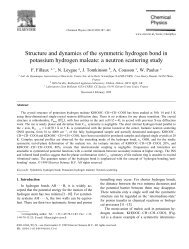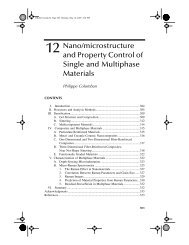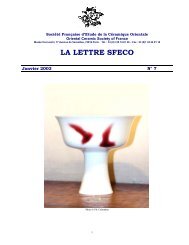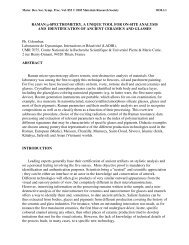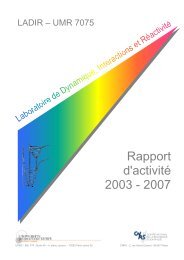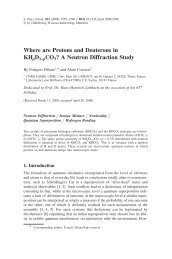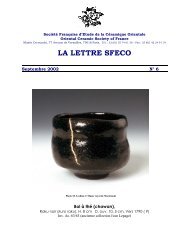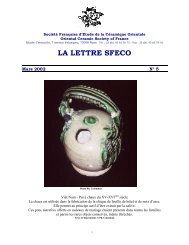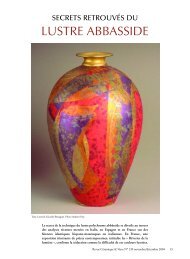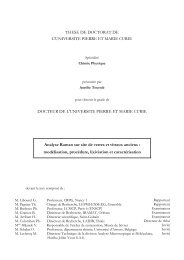Raman Spectroscopy of nanomaterials - institut de chimie et des ...
Raman Spectroscopy of nanomaterials - institut de chimie et des ...
Raman Spectroscopy of nanomaterials - institut de chimie et des ...
You also want an ePaper? Increase the reach of your titles
YUMPU automatically turns print PDFs into web optimized ePapers that Google loves.
ARTICLE IN PRESS+ MODELG. Goua<strong>de</strong>c, Ph. Colomban / Progress in Crystal Growth and Characterization <strong>of</strong> Materials 23xx (2007) 1e56obvious from the figure that the GeO 4 t<strong>et</strong>rahedra as well as GeO 6 octahedra are more distortedin the mesoporous glass than in the gel phase [298]. In the example <strong>of</strong> the perovskite-relatedniobiates from Fig. 10b, the NbeO mo<strong>de</strong>s around 800 cm 1 are split because <strong>of</strong> the occasionalpresence <strong>of</strong> oxygen vacancies in the NbO 6 octahedra. The (T 0 ,R 0 ) mo<strong>de</strong>s involving the Baatoms located at the corners <strong>of</strong> the unit-cell are not modified by these vacancies in Ba 6 Nb 2 O 11(hence the fine peaks) but are split again in Ba 4 Ca 2 Nb 2 O 11 because chemical and mass <strong>de</strong>couplingisolate the Ba and Ca sub-lattices [299]. The same kind <strong>of</strong> vibrational <strong>de</strong>coupling due to<strong>de</strong>fects has been observed for many silicates [296,297,300].Two silicate spectra are shown in Fig. 11a and b. Most types <strong>of</strong> glass contain nanom<strong>et</strong>riccrystallites and the spectrum <strong>of</strong> silicates (SiO 2 t<strong>et</strong>rahedral n<strong>et</strong>work) is intermediate b<strong>et</strong>weenthat <strong>of</strong> a disor<strong>de</strong>red n<strong>et</strong>work and the superposition <strong>of</strong> contributions from <strong>de</strong>finite vibrational entities:t<strong>et</strong>rahedra rings in vitreous silica (the narrow <strong>de</strong>fect bands in Fig. 11a originate from thevibrations <strong>of</strong> threefold (D 2 ) and fourfold (D 1 ) rings [301e304]) and complex arrangements <strong>of</strong>SiO 4 t<strong>et</strong>rahedra in alkali/earth-alkali silicates [301]. The <strong>de</strong>formation (d SieOeSi w 500 cm 1 )and elongation (n SieO w 800e1200 cm 1 ) mo<strong>de</strong>s <strong>de</strong>pend on the connectivity <strong>of</strong> the SiO 4 t<strong>et</strong>rahedraand can be fitted with components called Q n and Q 0 n , respectively (n represents thenumber <strong>of</strong> SieOeSi bridges per t<strong>et</strong>rahedron) [305e307]. The position and area <strong>of</strong> these componentsthen constitute characteristic param<strong>et</strong>ers <strong>of</strong> silicate glass nanostructures and can beused for garnering additional information such as the original composition or the sintering temperature[305,306].The most specific part <strong>of</strong> glass spectra is a band peaking at w50 to 100 cm 1 , which iscalled the Boson Peak (BP) because its intensity obeys a BoseeEinstein distribution. Since(a)Bendingmo<strong>de</strong>sStr<strong>et</strong>chingmo<strong>de</strong>s(b)MolecularsignatureD 1*D 2Wavenumber / cm -1Intensity / a.u.**BosonPeakBosonPeak00 75 150 500 1000Fig. 11. (a) <strong>Raman</strong> spectrum <strong>of</strong> pure glassy silica (macro-configuration, l ¼ 406 nm; D 1 and D 2 : see text). (b) <strong>Raman</strong>spectrum <strong>of</strong> a highly <strong>de</strong>polymerised potassium-rich calcium silicate stained glass (macro-configuration, l ¼ 413 nm;stars indicate plasma lines from the laser).Please cite this article in press as: G. Goua<strong>de</strong>c, Ph. Colomban, Prog. Cryst. Growth Charact. Mater. (2007),doi:10.1016/j.pcrysgrow.2007.01.001



